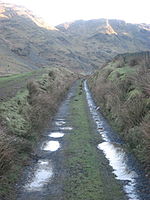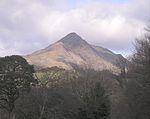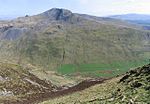Croesor quarry is a large underground slate mine in North Wales which was served by Croesor Tramway. Small scale quarrying began in the 1846, and by 1861, there were two companies in operation. They amalgamated in 1865, a year after the quarry was connected to the newly opened Croesor Tramway. Much money was invested in development work, but volumes of useful slate produced were small, amounting to just 226 tons in 1868. Access to the underground workings was by a single adit, and the surface mill was powered by two water wheels. A change of ownership in 1875 did little to improve the profitability of the quarry, and it closed in 1878 or 1882.
In 1895, the quarry reopened under the direction of Moses Kellow, a fearless innovator who set about modernising working practices and methods. The two-man teams working in the mill were no longer tied to a two-man team working underground, which enabled the mill to operate more efficiently. Following trials with air drills, he decided instead to electrify the mill, building a large hydro-electric station, which generated three-phase alternating current, rather than the direct current recommended by British manufacturers. He obtained motors from Prague, which were used to drive winches and an electric locomotive, the first to work in Wales. The water wheels were supplemented by Pelton wheels, supplied by Gilbert Gilkes of Kendal. His greatest innovation was the Kellow drill, a hydraulic drill for which he obtained six patents between 1898 and 1915. It could drill a 7.5-foot (2.3 m) hole in the slate in under two minutes, much less than the day required using hand drills. The mine was ventilated by a Guibal fan, housed in a fan-house near the entrance to the adit. Peak output under Kellow's direction was between 5,000 and 6,000 tons per year, though it declined in the later years, until the quarry closed in 1930.
The chambers were used by Cookes Explosives to store propellants from the late 1940s until the early 1970s. This ceased when the Central Electricity Generating Board became aware of it, and feared that an underground explosion would damage the dams of the Ffestiniog pumped storage power station. Both lakes were drained until the explosives had been removed. The quarry was worked on seven levels, but the three below the adit level are now flooded. There was an underground link to the nearby Rhosydd quarry, and the "Croesor Rhosydd Through Trip" is a well known, if somewhat dangerous, route for mine explorers.











